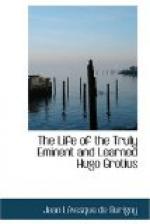Laet easily shewed that Grotius’s conjectures were ill founded, and that he had even advanced several facts which were not strictly true: he denied the existence of the city of Norembega, and maintained that Jucatan is too distant from Africa for the Ethiopians to penetrate into America, it being at least two months sail from Ethiopia to Jucatan. He refutes the pretended traces of Christianity, which Grotius said were found in that part of America before the discovery of the Spaniards, supporting his confutation on the authority of Spanish writers; in fine, he denies that any Chinese wrecks have been found on the coasts of the Pacific Ocean, and censures, as a very great inaccuracy in Grotius, what he advances concerning the Peruvian manner of writing.
After doing justice to the excellent judgment and profound erudition of Grotius, he ventures to assert, that he found nothing in his Dissertation that could satisfy a man moderately acquainted with the History of America; and approves of what was observed by Joseph Acosta, that it was easier to confute what was written on the origin of the Americans, than to know what to hold; because there were no monuments among them, nor any books of Europeans to throw light on this matter: and hence concludes, that it is rashness to promise truth on such an obscure subject.
Laet’s answer vexed Grotius: he replied to it in a second Dissertation, entitled, Adversus obtrectatorem, opaca quem bonum facit barba. Printed at Paris by Cramoisi, in 1643. Laet answered in a piece, printed in 1644, by Lewis Elzevir, in which he inserts Grotius’s second Dissertation. There is nothing new in these two last books: and it were to be wished that they had been written with less bitterness. It has been[533] observed, that Grotius’s system is not new; and that it had been already advanced by Myl, whom Grotius does not once quote.
FOOTNOTES:
[532] This work was printed at Paris the same year.
[533] Hornius, de Orig. Gent. Amer. l. 1. c. 2. p. 17.
XIV. It now remains to give some account of the other works of Grotius, which hitherto we have not had occasion to mention. In 1629, he printed at William Blaeu’s the History of the Siege of Grolla: Grollae obsidio cum annexis anni 1627. This piece would have been brought into his History[534] if he could have continued it. He speaks of it with great modesty[535] in his letters to his brother. “I don’t expect, he says, much honour from such a small tract.”




